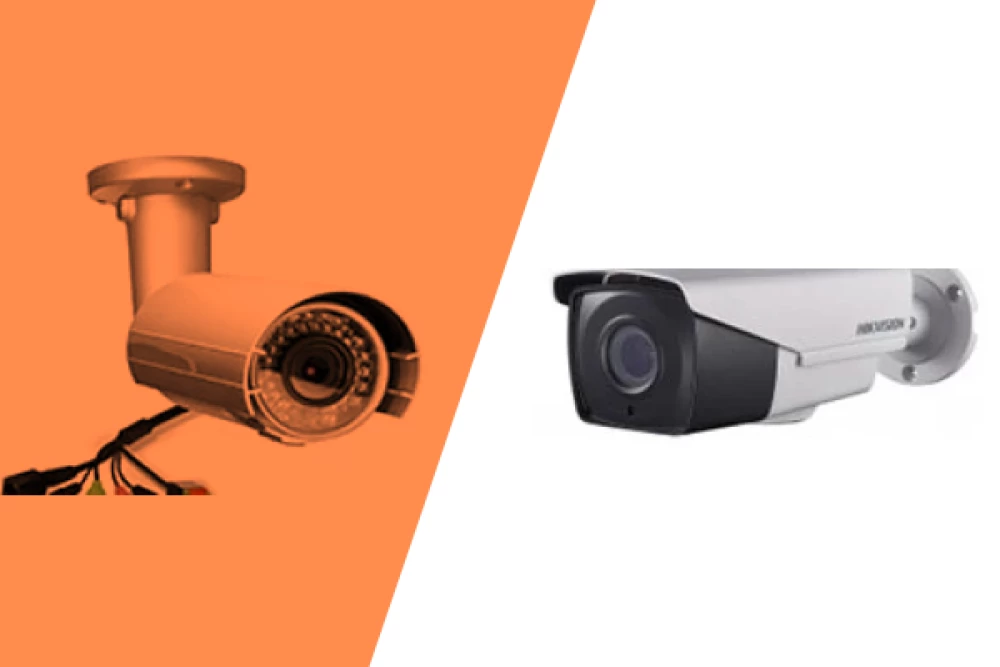Video Surveillance & Security
IP Cameras vs Analog Cameras: Which Solution Should You Choose for Reliable Video Surveillance?

Analog Cameras: A Still-Viable Technology, but with Clear Limitations
Analog systems rely on coaxial cables and DVR recorders. They were long considered the standard due to their ease of installation and low initial cost. Despite the massive rise of IP technologies, analog remains widely deployed, mainly for economic reasons.
Modern analog cameras offer improved resolutions thanks to HD, AHD, CVI, or TVI technologies, which provide acceptable image quality without replacing the existing coaxial infrastructure. This is a major advantage for older installations: it is possible to upgrade without recabling. However, these resolutions remain limited when compared with modern IP sensors, and the upgrade potential is restricted.
One major drawback of analog systems lies in video processing. DVRs are centralized devices that handle encoding, and any DVR failure results in complete loss of recording. While bandwidth is not a concern for analog systems, this also means the surveillance network is fully isolated from the IT network, offering limited remote access or integration capabilities. Image quality also depends heavily on cable distance and electromagnetic interference, sometimes requiring additional amplifiers or signal adapters.
IP Cameras: Superior Image Quality and a Flexible, Future-Proof Architecture
IP cameras use the IT network to transmit their video streams. They are powered through Ethernet thanks to PoE and communicate with an NVR or cloud platform. This architecture provides several significant technical advantages, making IP the dominant solution in 2025.
The first major benefit is image quality. IP cameras offer resolutions ranging from 2 MP to 12 MP and beyond depending on the model. This level of detail is essential for identifying critical elements: license plates, faces, suspicious behaviors. High-sensitivity sensors, intelligent infrared lighting, and onboard processing ensure high-quality images both day and night.
Network flexibility also allows much more versatile deployments. Cameras can be installed over long distances without signal loss, using PoE switches, fiber links, or existing network infrastructures. Adding or moving cameras is simpler: just connect the new device to the network, with no coaxial distance constraints.
IP cameras also integrate advanced features such as intelligent motion detection, behavioral analysis, line-crossing detection, people counting, and integration with third-party systems (access control, alarms, monitoring platforms). These features often require no additional hardware, as they are embedded directly in the cameras or managed by dedicated software.
Finally, maintenance is greatly simplified. Firmware updates, device supervision, and alerts for outages or failures can all be centralized. Administrators can intervene remotely, analyze streams, or adjust settings without needing to be physically on-site.
How to Choose Between IP and Analog: Key Criteria, Constraints, and Best Practices
The choice between IP and analog cameras depends mainly on the installation context, budget, surveillance objectives, and technical constraints. For a site equipped with aging coaxial infrastructure, upgraded analog solutions can be a cost-effective compromise. They allow improved image quality without replacing all wiring, lowering initial investment. However, this approach quickly reaches its limits if higher resolutions or advanced features are required.
For facilities looking to modernize their systems or deploy new installations, IP clearly stands out as the most suitable choice. Its scalability, superior image quality, and compatibility with modern networks ensure long-term viability. Using PoE switches also reduces power-related installation costs, while centralized management significantly improves system availability.
Site topology is another decisive factor. For large, complex, or multi-building environments, IP provides unmatched flexibility, particularly thanks to fiber or point-to-point links. Conversely, older buildings equipped with coaxial cabling may justify keeping analog systems if the budget is tight and advanced analytics are not required.
Lastly, integration within the overall infrastructure must be considered: compatibility with the existing IT network, proper segmentation to isolate video streams, NVR or cloud capacity, and storage quality. Video surveillance should not overload the network or the information system, making a well-balanced system design essential.
MAG.
Wi-Fi & Network
Cybersecurity & Backup
Video Surveillance & Security
Consulting
IT Managed Services
Video Surveillance & Security

Video Surveillance & Security
Video Surveillance in Hotels: Security, Compliance and ...
Why Video Surveillance Has Become Essential for Hotels In a hotel environment, security relies on ...
+
+

Video Surveillance & Security
How to Size a Video Surveillance System: Resolution, Camera ...
Choosing the Right Resolution: Detail, Identification, and Bandwidth Constraints Resolution is the ...
+
+
Your hotel deserves IT excellence
Let's discuss your challenges, whether you're in the hospitality sector or an SME.